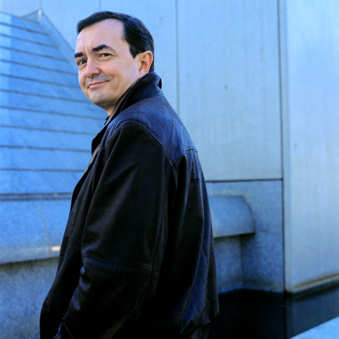Other Links
Editorial Board
- Editor - Bill Kenny
- London Editor-Melanie Eskenazi
- Founder - Len Mullenger
Google Site Search
SEEN
AND HEARD RECITAL REVIEW
Messiaen, Vingt Regards sur L’Enfant
Jésus: Pierre-Laurent Aimard (piano) Queen Elizabeth
Hall, London, 13. 2.2008. (AO)
In many ways, Vingt Regards sur L’Enfant Jésus is
quintessential Messiaen. Meditation is an important part of all
spiritual discipline and Roman Catholics follow the Stations of
the Cross because the visual images heighten response to the
meaning of Christ’s crucifixion. In Vingt Regards, Messiaen
presents a series of images in sound, each stage illuminating a
different aspect of Christ’s birth. Messiaen’s “stations of the
Nativity” is an inner pilgrimage, rewarding contemplation with
insight into how music can express concepts too profound for mere
words.

Pierre-Laurent Aimard
Vingt Regards begins in silence, long before a single note
is heard. Aimard sat utterly still for a while before even
reaching out towards the keyboard. Obviously, he reveres the music
and the composer, who was like a father to him. Yet this moment of
reverential calm is artistically crucial. It is a transit from the
bustle of the outside world into a mood of mystical veneration.
Aimard played the first Regard du Père with such controlled
pace that the gaps between notes seemed to hover, creating space
for the images to unfold gradually in the imagination. He managed
too, to extend the vibration of the piano strings for an
extraordinarily long time, so they floated long after the keys
fell still, soundwaves extending into the void. It was as if the
piano were being played by an invisible presence. Perhaps it was,
for Messiaen’s intention was to express the divine through music.
The central mystery of the Nativity is the idea that God becomes
man. Medieval paintings depict the Madonna gazing with rapture,
yet also emphasize the human nature of her relationship with her
child. Again, Messiaen portrays this intimacy in his music by the
gentle, unhurried atmosphere. Aimard brings out detail, like the
steady ostinato of the Virgin’s heartbeat, rising with excitement
as the Angel announces her pregnancy. Later Le Baiser de
L’Enfant-Jésus interlaces the divinity theme with playing of
great warmth and delicacy. It was ecstatic here.
Yet always in the background is the Crucifixion. The sixth Regard,
Par lui tout a été fait, frantically turns back on itself,
as if in time itself. The ostinatos scream and the glistening
“starlight” chords shoot backwards as if they were being sucked
back into a black hole. Aimard makes virtuosity seem easy but it
isn’t. So perfect was his discipline in the 19th Regard, Je
dors, mais mon cœur veille, that, although the pace was again
extended, each note flowed lucidly. Then Aimard launched into the
magnificent final Regard sur l’Église d’Amour. The colours
here were exquisite. Again and again that confident ascending line
appeared, with flourishes and sudden descending bass, as if it
could also stretch out into infinity. Each time, Aimard revealed
new, shining nuances. It was utterly exquisite. I wanted time
itself to stand still, hardly daring to breathe.
This really was a historic performance. Aimard knows how important
this South Bank tribute is, and how it will affect Messiaen’s
reputation for decades to come. He spared nothing. This was
perhaps the performance of a lifetime, eclipsing the remarkable
1999 recording in terms of depth and maturity. At the end, he
looked shattered and ecstatic in equal measure, for this is music
that refreshes the soul even though it must be gruelling to
perform. But he must have felt rewarded that the entire QEH
audience was standing in ovation. This wasn’t at all the kind of
audience that goes to piano recitals to chase celebrities, rather
than caring what music is being is being played (as long as it’s
safe). On the contrary, this was an audience who were genuinely
interested in Aimard’s approach to Messiaen. There were many
composers and musicians present, some from France, Germany and
Japan; but whatever their backgrounds, most people at this
concert were there because they sincerely wanted to engage with
this amazing music. Aimard, too, had his priorities right. He
bowed several times to a small group of students seated on
makeshift seats beside the piano, where they could watch his
fingering and pedal in greater detail than could be seen in the
stalls. One day, perhaps, it will be students as enthusiastic as
these who will take on the mantle of performance, bringing
Vingt Regards to audiences still unborn.
Anne Ozorio
Picture © Guy Vivien
Back
to Top
Cumulative Index Page
